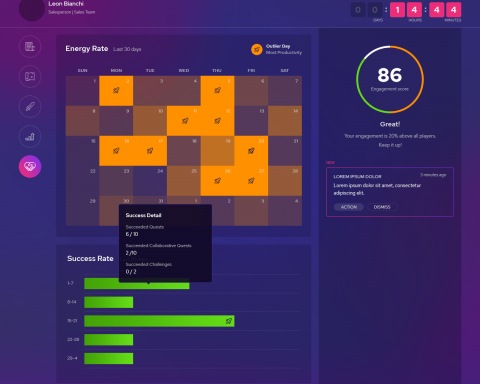Every time you think about sales productivity, what comes to mind right away:
- Sell a lot?
- Be quick at all stages?
- Do everything with a lot of quality?
If you have ever thought of any of these options as synonymous with productivity, you are on the right track, but what you will understand better with this post is that being productive is about the connection between them.
After all, what is sales productivity?
In any research you do on the topic “productivity” you will find several meanings.
However, in general, it is defined as the output (goods produced, such as products and services generated) in relation to the input (resources, such as labor, consumable materials, and equipment).
So when it comes to sales productivity, the meaning is nothing more than maximizing sales results and minimizing resources spent, such as cost, effort, and time.
Productivity Score
It was thinking about the importance of a productive culture for sales teams that we created this method of analyzing team performance to show how good the sales process is.
Our platform not only diagnoses the team’s productivity but also enables real-time monitoring of indicators through the Insight Generator.
Based on the studies by Slack et al. (2013) regarding productivity performance measures, our methodology is composed of 3 perspectives:

Speed
Get things done fast by minimizing waiting time.
A process aligned with the company’s speed allows greater productivity within standards appropriate to the company’s vision and culture.
This indicator is measured using the Average Win Cycle, which is the average speed that your new deal becomes new customers.
Dependability
Make things dependable by keeping the promises of delivery.
This is an indicator of how well the sales process has been operated.
Being out of the target shows that the perception of the process may have changed or that the reality of the negotiations is not in line with the company’s ideal expectation.
This indicator is measured using the Conversion Win Rate, which is the rate of leads that are turned into customers and by the Average Time for Rotten Deals, the metric that is used to keep your reps attentive and avoid deals to rotten.
Quality
Doing the right things influences the level of consumer satisfaction and with that, builds long-term relationships generating opportunities for cross-selling products and services.
Maintaining a reliable process within the company’s objectives allows the business to be observed more intelligently. It is the balance point of stability that the team generates.
This indicator is measured by Average Purchase Value, which is related to how much the sales value should be, in general, and also by Average Done Activities, the number of activities that must be carried out per transaction may vary according to the company and the sales cycle.
Whether you are a manager or a sales rep, productivity is undoubtedly a daily necessity to reach your goals.
Therefore, in addition to identifying the productivity score, it is important to act on the application of good practices to collaborate for the best result.
This is where gamification comes in and makes caring for productivity fun, healthy, and motivating.
You can start this productive journey right now with Gamifier.
PS: If you want to know more about the results of this combination, leave your email here and we will share with you a case study done with one of our clients. (:









Follow